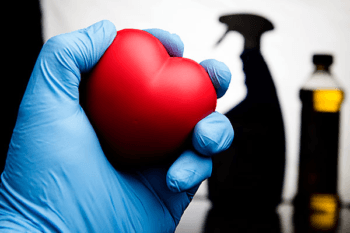How Do Environmental Toxins Affect The Heart?

Even though the World Health Organization (WHO) estimates that up to 23 percent of the global burden of cardiovascular diseases—the leading cause of death worldwide—can be attributed to environmental chemicals, we really don’t know much about these substances.
David Threadgill, Ph.D., a university distinguished professor in the Department of Molecular & Cellular Medicine at the Texas A&M Health Science Center, had been thinking about the problem and possible ways to approach the research, so when the United States Environmental Protection Agency (EPA) put out a call for proposals to study toxicity using “organoids,” three-dimensional organ–like structures grown in cell culture, he and his collaborators jumped at the opportunity. An organoid has multiple types of cells, just like a real organ does, but it lives entirely within a dish and it is far easier to use for chemical testing. They are thought of as a kind of bridge between conventional, single-layer cell cultures and whole-animal systems.
Together with his long-term collaborator, Ivan Rusyn, M.D., Ph.D., professor of veterinary integrative biosciences at the Texas A&M College of Veterinary Medicine & Biomedical Sciences (CVM), Threadgill was awarded a $6 million grant by the EPA to fund a multi-institutional collaboration to study how heart cells react to different chemicals. The long and growing list of substances used in industry that get into the environment was what prompted the EPA to seek research that would study their toxicity. Without this information, the EPA cannot make good decisions about which substances to regulate, let alone how. This lack of regulation could turn out to have major public health implications if it is later discovered that the chemicals are harmful.
“Some of us had already been thinking about organoids and how we could use those as sensors for environmental chemicals,” said Threadgill, who is also a professor in the Department of Veterinary Pathobiology at the CVM, “and we decided to focus on cardiotoxicity, because we knew that the heart is the organ second-most (after the liver) influenced by toxins, but the one that we know least about.” Threadgill had some experience looking at cardiotoxicity in drug studies, but this was the first time he applied those techniques to chemicals in the environment—and very few other people have either. Methods for assessment of cardiac safety of non-pharmaceutical agents are lagging behind the traditional health hazards of concern to human health.
Recent advances in using stem cells to develop models of functional cardiac muscle cells has led to new prospects for simulating complex chemical outcome pathways in the beating heart. Threadgill’s lab will use induced pluripotent stem (iPS) cells to create little beating organoid “hearts” in culture, with iPS cells coming from 100 different strains of the animal model—creating variation similar to what you would see in the human population.
Continue reading on Vital Record.
This article by Christina Sumners originally appeared in Vital Record.





